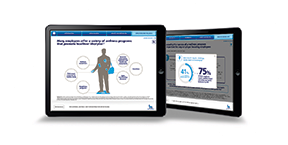Andrew Gottfried, managing partner, director of client services at Entrée Health, doesn’t mince words when he describes 2014 as a “challenging year.” At the beginning of 2013, corporate parent CDM Group spun off part of Entrée Health into Entrée Health Princeton, which almost immediately began to operate independently of its former agency. The spin-off had the consequence of concentrating most of the elder firm’s work in a single client, Novo Nordisk.
 You can guess what happened next. When Novo shifted part of its business elsewhere, Entrée felt some pain. “That was a longstanding relationship for us, and it created a challenge financially and culturally,” Gottfried admits. The agency faced another setback in 2014 due to the delay of two Amgen cardiovascular drugs: Corlanor for congestive heart failure, which was just released, and cholesterol-lowering PCSK9 inhibitor Repatha, which is expected to launch in the next few months.
You can guess what happened next. When Novo shifted part of its business elsewhere, Entrée felt some pain. “That was a longstanding relationship for us, and it created a challenge financially and culturally,” Gottfried admits. The agency faced another setback in 2014 due to the delay of two Amgen cardiovascular drugs: Corlanor for congestive heart failure, which was just released, and cholesterol-lowering PCSK9 inhibitor Repatha, which is expected to launch in the next few months.
Despite those challenges, Entrée has an optimistic outlook for the rest of 2015 and beyond, forecasting 5% to 10% revenue growth over 2014. Managing partner, creative director Nina Greenberg says that the company will likely hire 10 more staffers in the months ahead, which would bring head count to 70. Entrée reported 80 full-timers at this time last year.
 On the client front, the agency added work from Clovis Oncology for its non-small cell lung cancer drug rociletinib, winning the market access and reimbursement responsibilities for the investigational treatment. It’s also worth noting that Entrée is still in business with Novo: It remains the brand agency of record on the market access side for diabetes drug Victoza and recently contributed to the launch of weight-loss medication Saxenda.
On the client front, the agency added work from Clovis Oncology for its non-small cell lung cancer drug rociletinib, winning the market access and reimbursement responsibilities for the investigational treatment. It’s also worth noting that Entrée is still in business with Novo: It remains the brand agency of record on the market access side for diabetes drug Victoza and recently contributed to the launch of weight-loss medication Saxenda.
Another reason for optimism, Greenberg says, is that Entrée’s long-cultivated payer expertise has become increasingly valuable as the dialogue around drug access continues in the US. “When we started in this business 18 years ago, if you worked on the access side, you talked to health plans,” she explains, describing a far different competitive landscape. “The stakeholders in the healthcare system are now fracturing. It’s much more diverse.”
She adds that this has given rise to any number of communication challenges. “One of the biggest barriers to drug [adoption] is whether patients can actually afford it. In this moment, when PBMs and health plans are controlling so many dollars, they’re giving more and more responsibilities to patients in the form of co-pays and co-insurance.”
This has led many manufacturers to create reimbursement hubs that, Greenberg continues, “enable physicians to understand what a patient’s co-share is going to be for a drug before they prescribe it.” This scenario comes with the benefit of connecting patients with financial assistance. “[These hubs] are a huge driver for the bottom line of biotech and pharmaceutical manufacturers.”
The growing importance of payer access has another effect on Entrée Health: It’s made the agency a more desirable landing spot for ambitious, talented marketers and communicators. “It used to be that people didn’t want to work in the access arena,” Greenberg explains.
To keep employees up to date on developments in the fast-evolving space, the agency has instituted what it calls “Access Animals,” a monthly mandatory training program for all employees. “This is our way of keeping everyone up to speed,” Greenberg notes. “Our philosophy is to hire brilliant people who show a great spark for this and train them.”
From the July 01, 2015 Issue of MM+M - Medical Marketing and Media








